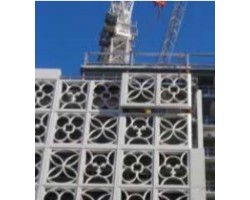Beauty is in the eye of the beholder – a phrase that neatly sums up the work of the government advisory Building Better, Building Beautiful Commission. Elaine Toogood, Senior Architect, The Concrete Centre, illustrates how concrete helps deliver a bespoke, natural aesthetic and superb structural performance.
Created to promote and increase the use of high-quality design for newbuild homes and neighbourhoods, the Building Better, Building Beautiful Commission recently issued their interim report ‘Creating Space for Beauty’ with their final recommendation expected in December. With a subjective premise such as beauty at the heart of the initiative the question is how can this influence design? And how does beauty interact with quality and quantity? Is the risk of offsite solutions that spaces will be dominated by the monotony of repetition and produce unstimulating places?
The selection and design of the materials that will remain visible in a development is key to securing beauty and great place making - and the report identifies this for consideration at building scale. Precast concrete cladding offers designers such a range of aesthetic options that there is no need to compromise on beauty, quality or speed of construction.
As I explored in more depth in Issue 9 of this magazine, contemporary, architectural precast concrete is as likely to resemble Portland stone, black polished marble or have a patterned relief in terracotta. It may not even be perceived as concrete at all, hidden
behind an embedded layer of brick or stone. In fact, offsite construction using architectural precast concrete is uniquely placed to create high quality buildings, with interest and delight.
Sophisticated moulding, advances in mixes and a greater variety of finishing techniques mean that exposed precast concrete can demonstrating craftmanship and intricate detail. Elaborate brick detailing, with stepped corbels, for example, becomes costeffective when factory manufactured as brick-faced concrete cladding, as illustrated by Maccreanor Lavingtons Garden Place student housing.
Form, colour, texture shape of architectural precast concrete can all be selected and designed to suit location. Natural sands and aggregates are the principle means of providing colour, creating the opportunity to enhance or reference local vernacular, without pastiche. Pigments can also be added to great effect. Natural, earthy colours are most common, but greens and blues are also available.
New digital manufacturing techniques for formwork such as five-axis routers, greatly simplify the creation of complex and ornate shapes, texture and pattern. Reusable formwork liners can also create varied textures and pattern, ranging from stone or even timber textures, to bespoke ornamental features.
To just talk about façade design in the context of this debate for improving the quality of the building environment falls way short of the myriad of issues that need to be addressed and which have been included in the report. Architectural precast concrete offers many opportunities to contribute to the creation of beautiful places, as well as its other acknowledged benefits such as fire protection, low maintenance, durability, safety and speed of installation of site. Maintaining performance and aesthetic quality over the long term should be equally, if not more important to good place making.









